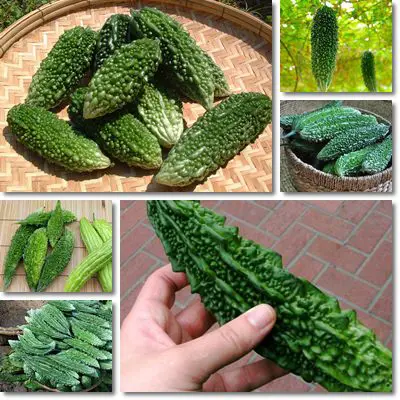Bitter melon (Momordica charantia), also commonly known as bitter gourd, goya or karela is a fruit in the gourd family reputed to possess amazing anticancer, anti-diabetic, antioxidant and immune-boosting properties. The bitter melon is renowned for its bitterness, as well as for its curative properties. Traditional Chinese, Turkish, Indian and African medicine praise it as an efficient natural anti-diabetes remedy and recommend it for treating skin infections and skin disorders such as psoriasis.
Bitter melon is also said to help with colic, constipation, nausea, intestinal parasites, gout and as a stomach tonic and digestion aid. Bitter melon is also a favorite ingredient in Okinawan and mainland Japanese cuisine and, at the same time, highly valued in traditional Chinese and Indian cooking. It is the main ingredient in the famous Okinawan dish, Goya chanpuru, and a preferred choice for Indian curries as well as traditional Chinese pork and dumpling soups and herbal infusions.
See the benefits of Goya chanpuru.

Where can you find bitter melon?
This cucumber-like fruit thrives in tropical and subtropical climates. As a result, it is widely cultivated throughout Africa, the Caribbean and Asia. There are several different varieties of bitter melon which differ from country to country, but the fruit remains a favorite in Okinawa, Japan, China, India, Pakistan, Thailand, Nepal and Bangladesh. It goes by many names, depending on the country where it is employed. Popular names for Momordica charantia include: bitter melon, bitter gourd, karela, karla, carilla, goya, nigauri, balsam apple, balsam pear, poire balsamique, courge amère, cerasee or vegetable insulin.
What does bitter melon look like?
Despite the fact that it comes in a relatively wide range of varieties, bitter melon is easily recognizable due to its close resemblance to the common cucumber: elongated, with green ridged or bumpy skin and large seeds.
Indian bitter melon
The popular Indian bitter melon, the same variety used in Okinawan and Japanese cuisine, is generally 10-20 cm long, has a thick, dark green skin, full of wart-like bumps and pointy ridges. It has an elongated, cucumber shape, with pointy ends. The flesh is whitish and contains large, irregular-shaped reddish-brownish seeds.
Chinese bitter melon
The Chinese bitter melon has a lighter green skin, softer bumps or ridges and ranges from 10-15 cm to 20-30 cm in length. This variety is fuller in width and looks more like a zucchini than a cucumber. Bitter melons are traditionally consumed while still green, but they are edible even when their skin starts turning yellow or brown. Color indicates a different ripening level.

What does bitter melon taste like?
Its name gives away its taste: bitter. While there may be slight variations between cultivars, bitter melons have a decidedly bitter taste, which is why they are an acquired taste for first-timers. Bitter melon has a crisp, cucumber-like texture. Green ones are quite tender and require little to no cooking, especially if sliced finely, while yellow or brownish bitter melons have a chewier texture. Despite being a fruit, bitter melon is used as a culinary vegetable. The fact that it looks a lot like a bumpy, ridged cucumber adds to the confusion.
What are the benefits of bitter melon?
The fruit is beginning to enjoy an increase in popularity as a result of studies asserting its beneficial effects on human health, most notably disease management and nutrition. Here are the 7 most noteworthy health benefits and nutrition facts of bitter melon:
Aids digestion
Rich in dietary fiber (2.8 g/100 g of fruit), bitter melon is a good natural laxative which stimulates peristalsis, a series of movements of the gastrointestinal muscles that help move food down the digestive tract. Regular consumption of bitter melon thus contributes to relieving constipation and, at the same time, supports healthy gut bacteria which favors digestion and nutrient absorption.
Helps combat infections
Traditional medical practices recommend the topical application of bitter melon for the treatment of skin problems such as psoriasis, as well as open wounds and skin infections. Although research on the matter is labeled as insufficient, it is believed that bitter melon can successfully battle skin infections due to its ability to cleanse the blood from toxins.
Great tonic
Bitter melon is a great source of essential nutrients, most notably vitamin C, folate, vitamin K, potassium, magnesium, phosphorus and zinc. Regular consumption of the fruit helps boost immunity, reduce infection rates and severity, improve blood pressure, muscle activity and maintain strong, healthy bones. And with only 17 kcal/100 g of fruit, bitter melon is an ideal choice for maintaining a slim waistline.
Good for bright skin and healthy eyes
Bitter melon is one of the few fruits that naturally purify the blood of toxins, giving the skin a healthy glow. In addition to brightening the skin, the fruit contains powerful provitamin A antioxidants (beta-carotene, alpha-carotene, lutein, zeaxanthin) which maintain retina health, protect against harmful free radicals from blue light especially and improve eyesight quality.
Boosts immunity
According to the National Nutrient Database for Standard Reference, 100 g of bitter melon contains 84 mg of vitamin C. Vitamin C not only supports the immune function, but also reduces the incidence, severity and duration of viral and bacterial infections, notably respiratory infections and maintains overall low inflammation markers, contributing to a lower risk of developing chronic illnesses (cancer, diabetes, heart disease, dementia etc.). The provitamin A antioxidants in bitter melon also contribute to good immunity.
Exhibits anticancer properties
An in vitro study conducted by Dr. Ratna Ray and colleagues at the Saint Louis University and the University of Hawaii (‘Bitter Melon (Momordica charantia) Extract Inhibits Breast Cancer Cell Proliferation by Modulating Cell Cycle Regulatory Genes and Promotes Apoptosis’, published in the February 23, 2010 issue of Cancer Research) showed that cultured breast cancer cells underwent apoptosis (programmed cell death) when exposed to liquid bitter melon extract. Although preliminary, these results encourage the consumption of bitter melon and bitter melon extracts as a means for breast cancer prevention.
Blood sugar lowering properties
Bitter melon has been found to help lower blood sugar levels and contribute to better diabetes management. Vicine, charantin and polypeptide-P are the three naturally occurring compounds that are responsible for the hypoglycemic and anti-diabetic properties of bitter melon. According to clinical studies, these compounds help improve insulin sensitivity, glycogen synthesis in the liver, reduce insulin resistance and overall blood glucose levels, sparking hope for the emergence of an alternative therapy for diabetes management and treatment.
Nevertheless, pregnant women are advised to avoid bitter melon because it increases the risk for miscarriages as a result of inducing contractions (see the 14 foods to avoid in pregnancy). Nursing mothers should also avoid bitter melon due to it containing several compounds that may prove harmful for babies. The reddish arils surrounding the seeds are also potentially toxic for young children. Other than this, bitter melon is safe for human consumption. Only mild side effects such as gastrointestinal discomfort or diarrhea are reported in particularly sensitive people who consume large amounts of the fruit.
Conclusion
Overall, preliminary research shows bitter melon is an amazingly healthy food, rich in essential nutrients and vital antioxidant compounds believed to offer significant anticancer and anti-diabetic protection, as well as stimulate immunity, reduce inflammation and improve digestive health. But there are many more secrets to this vegetable look-alike that Chinese and Okinawan centenarians love. Don’t let its bitter, unappealing taste fool you into thinking less of it.
